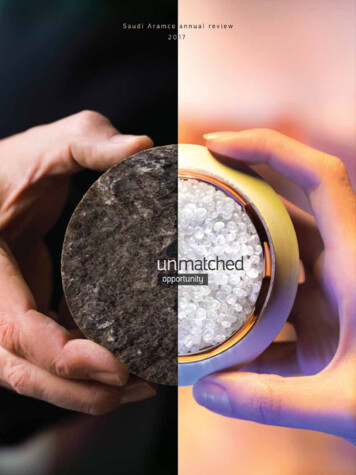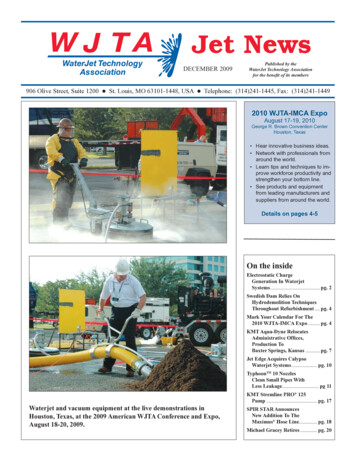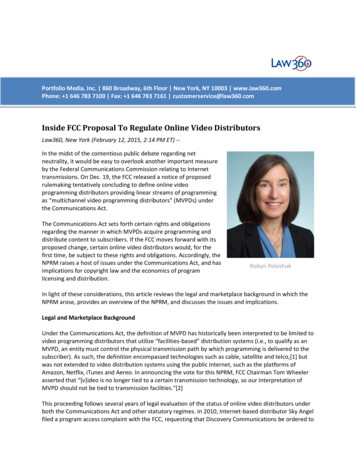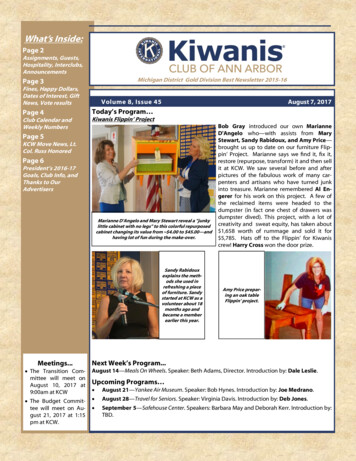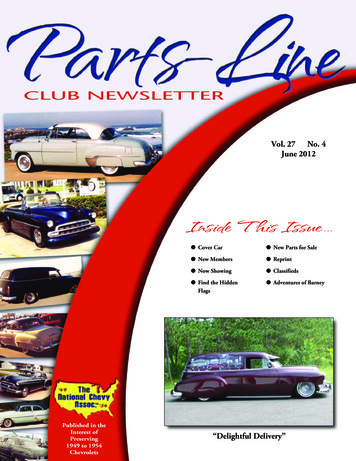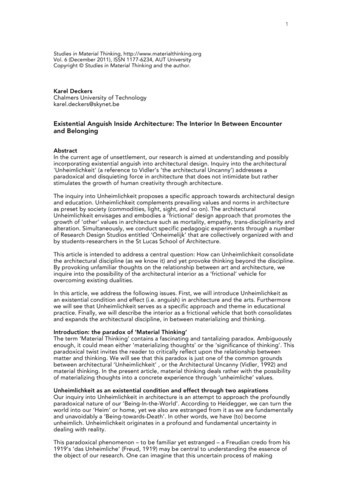
Transcription
1Studies in Material Thinking, http://www.materialthinking.orgVol. 6 (December 2011), ISSN 1177-6234, AUT UniversityCopyright Studies in Material Thinking and the author.Karel DeckersChalmers University of Technologykarel.deckers@skynet.beExistential Anguish Inside Architecture: The Interior In Between Encounterand BelongingAbstractIn the current age of unsettlement, our research is aimed at understanding and possiblyincorporating existential anguish into architectural design. Inquiry into the architectural'Unheimlichkeit’ (a reference to Vidler’s ‘the architectural Uncanny’) addresses aparadoxical and disquieting force in architecture that does not intimidate but ratherstimulates the growth of human creativity through architecture.The inquiry into Unheimlichkeit proposes a specific approach towards architectural designand education. Unheimlichkeit complements prevailing values and norms in architectureas preset by society (commodities, light, sight, and so on). The architecturalUnheimlichkeit envisages and embodies a ‘frictional’ design approach that promotes thegrowth of ‘other’ values in architecture such as mortality, empathy, trans-disciplinarity andalteration. Simultaneously, we conduct specific pedagogic experiments through a numberof Research Design Studios entitled ‘Onheimelijk’ that are collectively organized with andby students-researchers in the St Lucas School of Architecture.This article is intended to address a central question: How can Unheimlichkeit consolidatethe architectural discipline (as we know it) and yet provoke thinking beyond the discipline.By provoking unfamiliar thoughts on the relationship between art and architecture, weinquire into the possibility of the architectural interior as a ‘frictional’ vehicle forovercoming existing dualities.In this article, we address the following issues. First, we will introduce Unheimlichkeit asan existential condition and effect (i.e. anguish) in architecture and the arts. Furthermorewe will see that Unheimlichkeit serves as a specific approach and theme in educationalpractice. Finally, we will describe the interior as a frictional vehicle that both consolidatesand expands the architectural discipline, in between materializing and thinking.Introduction: the paradox of ‘Material Thinking’The term ‘Material Thinking’ contains a fascinating and tantalizing paradox. Ambiguouslyenough, it could mean either ‘materializing thoughts’ or the ‘significance of thinking’. Thisparadoxical twist invites the reader to critically reflect upon the relationship betweenmatter and thinking. We will see that this paradox is just one of the common groundsbetween architectural ‘Unheimlichkeit’ , or the Architectural Uncanny (Vidler, 1992) andmaterial thinking. In the present article, material thinking deals rather with the possibilityof materializing thoughts into a concrete experience through ‘unheimliche’ values.Unheimlichkeit as an existential condition and effect through two aspirationsOur inquiry into Unheimlichkeit in architecture is an attempt to approach the profoundlyparadoxical nature of our ‘Being-In-the-World’. According to Heidegger, we can turn theworld into our ‘Heim’ or home, yet we also are estranged from it as we are fundamentallyand unavoidably a ‘Being-towards-Death’. In other words, we have (to) becomeunheimlich. Unheimlichkeit originates in a profound and fundamental uncertainty indealing with reality.This paradoxical phenomenon – to be familiar yet estranged – a Freudian credo from his1919’s ‘das Unheimliche’ (Freud, 1919) may be central to understanding the essence ofthe object of our research. One can imagine that this uncertain process of making
2something ‘heimlich’ or worldly, and then deliberately abandoning this world (orbecoming un-heimlich,) may cause anguish. In this article, we invite the reader to inquireinto existential anguish as a creative force in architecture.While ‘Unheimlichkeit’ is a central issue in contemporary arts and has been so down throughthe centuries (think for instance of Rachel Whiteread, Anish Kappoor, Goya, Kafka, ), it hasbeen strangely absent in architectural discourse. Nevertheless, we can reveal Unheimlichkeitas a frictional and ambiguous phenomenon in architecture: a building can be perceived asfamiliar and yet also strange and this perception evokes a feeling of Unheimlichkeit. Forinstance, the hotel, as portrayed in Stanley Kubrick’s ‘The Shining’– a film rendition of thebook by Stephen King – transforms in the wintertime into a pandemonium of murder andhate, parallel to the evil transformation of the main character. Unheimlichkeit as a creativeforce in architecture relates to two basic human aspirations: the first is the yearning for ‘asense of belonging’ to a larger entity (a nation, a family, a person, a house, ). One canbelong to a particular place or person and so on. This urge is the expression of a universaldesire. As a ‘Being-in-the-World’, we can thus long for this carefree environment. In otherwords, upon finding such a place, one can finally belong to a safe and reassuring ‘home’ towhich one always returns: one has become ‘heimlich’ or homely.Yet this desire may be called into question by another aspiration: we can yearn for aparticular ‘sense of encounter’. This urge is rooted in an existential fascination withencountering the unknown i.e. the ‘other’. The encounter with the ‘other’ profoundly callsinto question the self-evident character of Heimlichkeit. By encountering the ‘other’, wemay – whether deliberately or not – jeopardize the familiar and comfortable house that wehave come to know: it becomes an environment for which to take care. In this sense, weare inevitably a ‘Being-towards-Death’.Perhaps architectural education focuses too one-sidedly on a harmonious ‘sense ofbelonging’ by insisting on heimliche forces. One can assume that the primary task ofarchitecture is to create a sense of protection or, in one word, a home. Why then leave thesecurity and safety of this home? Unheimlichkeit identifies this security as illusory: theinquiry deliberately engages with an intriguing world of not knowing, whereby unpredictedpossibilities may emerge. Thus, through the encounter with the unheimliche ‘other’, we arethrown into a ‘World-of-Possibilities’. In our research, we ask ourselves how this going backand forth between constructing a home and leaving home affects us. How does it changeour way of thinking as it calls into question our preset values? Our research identifies aprocess that has a frictional yet constructive influence on how we think, make and act. Inessence, the research into Unheimlichkeit is thus a constructive endeavour.Unheimlichkeit as a specific approach and theme in architectural educationWe started our research empty-handed in the academic year 2008-2009. What has been thespecific approach and initial framework utilized throughout the inquiry? In other words, howhave we been working? Through a series of Research Design Studios – the so called‘Onheimelijk’ Studios organized from 2008 onwards (Deckers et al., 2009) in the St LucasSchool of Architecture – we gradually developed a framework built upon educational practice.Fig. 1: The first publication following the ‘Onheimelijk’ Research Studio (Deckers, 2010)
3The inquiry focuses on educational practice and does not start with an a prioriunderstanding of Unheimlichkeit. The essence of the inquiry lies in the body of workconducted through, with and by students. We investigated how existential anguishcan become both a design factor and a leading theme in a Design Studio. Wegenerally focused on the emergence and formation of collective forces generated bythe encounter with the ‘other’. Parallel to producing an individual design, a student isalso asked to perform a collective task ‘set in the world’, which ultimately becomesmore relevant than the individual design. For instance, one of these collective taskswas to organize a temporary interior, such as organizing an exhibition of all studentwork in a totally unequipped environment such as an abandoned warehouse.The Studio also aims at combining practice and theory: we anticipated a ResearchDesign Studio in which the student would simultaneously learn to think strategicallyand act accordingly through the making of a design. This process is conducted byboth the student-researchers and teacher-researcher in charge of the Studio. Thewhole concept of the Studios is geared to monitoring the design process as it occurs.Our focus is upon monitoring and stimulating a creative process in order to obtainunexpected qualities, not a preset final design or a fixed end result.We also wanted to take distance from familiar settings. The ‘Onheimelijkheid’Research Design Studio explicitly starts from the idea that student-researchers do notbelong exclusively to a school environment, but belong to the world. The Studio thusdeliberately ‘de-familiarizes’ the participants from the school environment forinstance by altering neglected interiors located extra muros. Each year, we have builta temporary installation/exhibition outside the school walls.The Research Design Studio therefore takes architectural education to the streets andthus potentially generates encounters. Architecture, then, may be - or may not be this mythical and solitary act of designing. Architecture rather takes place and ischaracterized by our ‘Being-in-the-World’. Yet, simultaneously this ‘Being-in-theWorld’ is being questioned in the encounter with the ‘other’. Thus, there is a tensionemerging between our ‘Being-in-the-World’ and ‘Being-towards-Death’, i.e. thetragic yet necessary distance taken from the world. This paradoxical tension betweenthe present and mortality, between longing and encounter, can be fruitful inarchitectural education.Fig. 2: Project by Jonas Van Vliet, ‘Eb and Tide House‘ (Deckers et al., 2009)Take for instance, the student project by Jonas Van Vliet ‘Eb and Tide House‘(Deckers et al., 2009). This exemplary project in the research studio illustrates in myview a tragic dimension in architectural design. He designed a house that is subject tothe changing of ebb and tide. This design embodies a crossing of two contradictoryideas: a safe and predictable interior that encounters currents of salty water. The
4interior arrangements follow the natural rhythm of ebb and tide. By allowing water toenter, the interior continually contracts and expands. These changes transform theexperience of the interior into something intense and rich, into architecture. Theunderlying idea is that by accepting a continuously changing interior, we are able toturn something erratic into a quality.The tragic dimension could be described as follows: only when the forces of natureare allowed to overtake us, can architecture be possible. Paradoxically, as the interioris infiltrated with water, Unheimlichkeit, or something discomforting kicks in.Unheimlichkeit usually occurs when the natural order of things is reversed: natural yetunpredictable elements invade our common sense of security and commodity. Yetthis commodity in itself can be questioned: ‘Modern commodities threaten thestability of the world’ (Taylor, 1998).This student research project thus constructs ‘otherness’ through the notion ofUnheimlichkeit. One can ask: In what way could the outcome of the research with andby students be meaningful for the architectural discipline? In other words: How canUnheimlichkeit consolidate the architectural discipline and still provoke thinkingbeyond the discipline? Perhaps we ought to simultaneously familiarize with thediscipline as we know it, and de-familiarize (or estrange) from the discipline bydeliberately taking distance.Consolidation of the architectural discipline through Unheimliche valuesFirst we look at which architectural values potentially belong to Unheimlichkeit. Canthese unheimliche values consolidate the specificity of the discipline?Empathy can be described as an unheimliche value, i.e. a desire to ‘read’ andcomprehend somebody else’s mind. Through the act of designing, we start to learnto think and to imagine being somebody else. This is an intellectual encounter withthe ‘other’: it is a way to construct ‘otherness’. It is as if the architect were able toescape from him or herself in order to embody someone else. Throughout the designprocess, the architect is able to empathically switch roles: he or she can be a drawingartist, a speaker, a viewer or a listener all at once. ‘Designers learn to take on tworoles themselves. They learn to switch between viewer and drawer’ (Glanville, 2006).Empathy thus consolidates and strengthens the architectural discipline as we know iteven though it means altering the self. However, Unheimlichkeit deals with a moretypical desire to alter spaces. Transforming or altering existing spaces allows us tomake a link with architectural interiors. The profound alteration of the interiorarguably allows us to encounter the ‘other’ and thus construct ‘otherness’.Fig. 3: Interior refurbishment project by MVRDV at the TU Delft – an orange stage is insertedinto an existing interior and creates a stark ‘before and after’ effect.
5For instance, a drastic refurbishment of an interior such as by MVRDV profoundlyalters the previous state into something unexpected thus leaving us bewildered andin awe. ‘This is truly uncanny!’ Although profound changes may have altered thespace drastically, it is still possible to ‘belong’ to the altered space again afterwards.The interior may thus be a powerful instrument for creating a stark ‘before and aftereffect.’ It holds the key to understanding what alteration in time and space can mean.It becomes really unheimlich when these alterations become erratic and fall out of thecontrol of the architect. For instance, the alteration caused by climatic changes.Lawson already claimed that ‘weathering’ leads to fascinating changes in the interior(Lawson, 2005). Our ‘Heim
between architectural ‘Unheimlichkeit’ , or the Architectural Uncanny (Vidler, 1992) and material thinking. In the present article, material thinking deals rather with the possibility of materializing thoughts into a concrete experience through ‘unheimliche’ values. Unheimlichkeit as an existential condition and effect through two aspirations Our inquiry into Unheimlichkeit in .





